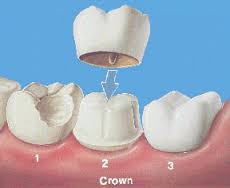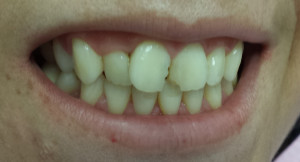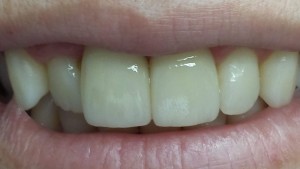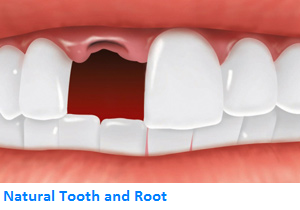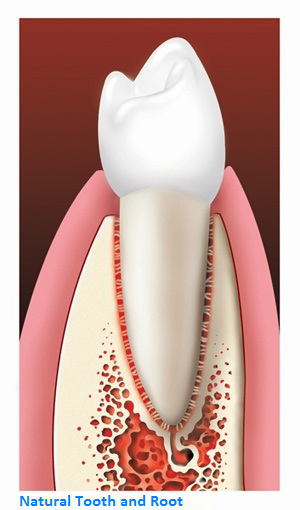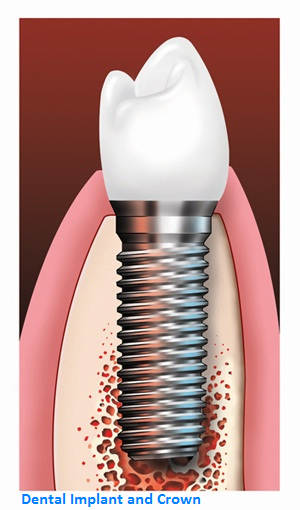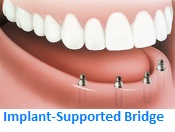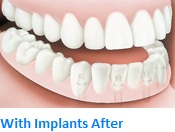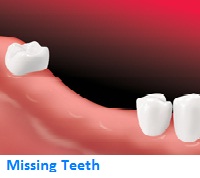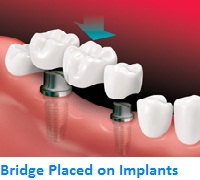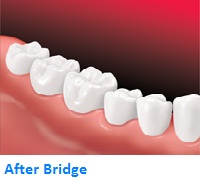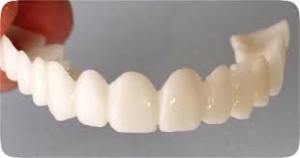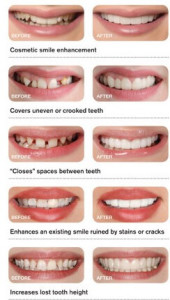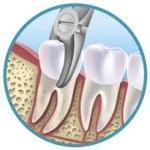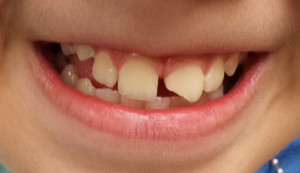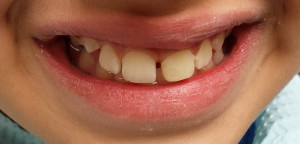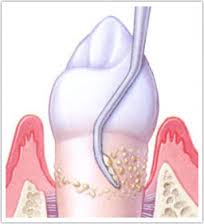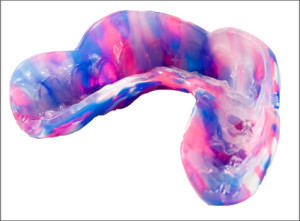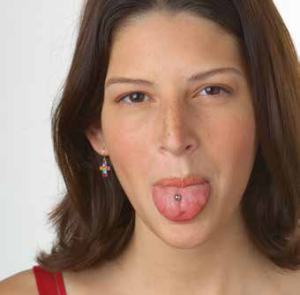Services
Our Services
- Crowns
- Dental Implants
- Dental Veneers
- Snap On Smiles
- Oral Surgery
- Complete Dentures
- Partial dentures
- Tooth Colored Fillings
- Bonding
- Periodontal Disease
- Dental clearance
- Occlusal Guards
- Custom Sports Mouthguards
- Snoring & Sleep Apnea
Crowns
A dental crown is a tooth-shaped "cap" that is placed over a tooth -- to cover the tooth to restore its shape and size, strength, and improve its appearance. The crowns, when cemented into place, fully encase the entire visible portion of a tooth that lies at and above the gum line.
Need Crown? Click here to
make an appointment
Crowns
A crown is a restoration that covers (or “caps”) a tooth to restore it to it’s normal shape and size.
Crowns are necessary when a tooth has damaged significantly and can not be adequately restored with a filling.
Indications
- Large decay
- Large filling which is breaking down
- Chipped/ cracked tooth
- Crowns can cover discolored or misshappened tooth for more aesthetically pleasing smiles.
Core build ups
when a tooth is severely decayed or fractured and lacks sufficient tooth structure a stronger filling material is used to restore a more ideal shape for supporting a crown.
In our office at primary family dental in Joliet and Plano family dental in Plano we use metal free porcelain crowns and Bruxzir crowns which are life like very esth
Bruxzir crowns
- Virtually unbreakable
- Ideal for Bruxzers and grinders
- Naturally looking , life like
- Resistant to chipping, breaking, cracking in mouth
All ceramic crowns
- Natural looking
- Able to transmit the color of adjacent teeth and tooth structure
- Enables them to blend more completely with surrounding natural teeth.
If you want a smile that’s your crowning glory, you may need a crown to cover a tooth to help restore it to its normal shape and size. A crown can make your tooth stronger and improve its appearance.
A crown can help strengthen a tooth with a large filling when there isn’t enough tooth remaining to hold the filling. Crowns can also be used to attach bridges, protect a weak tooth from breaking or restore one that’s already broken. A crown is a good way to cover teeth that are discolored or badly shaped. It’s also used to cover a dental implant.
Dental Implants $2499*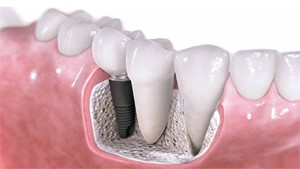
* Includes: Implant + Abutment + Crown. FREE CONSULTATION ($125 Value)
MENTION CODE: IMPT
0% FINANCING TO QUALIFIED INDIVIDUALS
CALL NOW: 630-552-9200. (Restrictions Apply)
Dental implants are an effective way to replace missing teeth. When teeth are lost because of disease or an accident, dental implants may be a good option.
You may want to choose dental implants if you:
Need Implants? Click here
to make an appointment
• hide your smile because you have missing teeth
• wear dentures that are uncomfortable
• are dissatisfied with your removable partial dentures
• want to keep your other teeth intact
Many people choose implants to replace a single tooth or several teeth, or to support a full set of
dentures. Implants are posts surgically placed into the upper or lower jawbone. They replace the root
of one or more missing teeth.
Dental implants are made of titanium (a strong, lightweight metal) and other materials that are well
accepted by the body. More than 5 million implants are placed each year by dentists in the United
States.
Benefits of Dental Implants
• Implants offer firm support to man-made teeth. Dentures, bridges or single teeth attached to the
implants won’t slip or shift in your mouth—a very important benefit when eating and speaking.
• This secure fit also helps man-made teeth feel more natural than typical bridges or dentures.
• Some people may find implant-supported dentures more comfortable than dentures that do not
use implants.
• Where teeth are missing, dental implants also help keep the jawbone from shrinking.
• Implants are a good value, because they can last a lifetime with good care.
Single Tooth Implants
The single tooth implant replaces the missing tooth’s roots. A single tooth implant is a stand-alone
unit and does not involve treating the teeth next to it.
If you are missing one or more teeth, there are many reasons why you should replace them:
• You may not like how the gap looks when you smile.
• Missing teeth may affect how you speak.
• A missing molar tooth can make it harder to chew.
• When a tooth is lost and not replaced, the teeth around it can shift.
• Bone loss can occur around the missing tooth. This may cause the remaining teeth to become loose
over time.
• Loss of teeth and bone can make your face sag. You may look older.
Implant-Supported Bridges and Dentures
Dental implants can be used to support a bridge when several teeth are missing. The
implant-supported bridge replaces the lost natural teeth and some of the tooth roots. Unlike
traditional bridges, an implant-supported bridge does not need support from the teeth next to it.
If you are missing all of your teeth, an implant-supported denture can replace the missing teeth and
some of the tooth roots. Because the dental implants integrate (or "fuse") with the jawbone, an
implant-supported denture tends to be comfortable and stable, allowing you to bite and chew
naturally.
Implant-Supported Denture
Implant-Supported Denture
What Is involved in Implant Placement?
Many kinds of implants are available. Treatment can take only one day, or it can take several months,
or somewhere in between. Your dentist and you can discuss which type of implant is best for you.
Implant treatment usually involves three basic steps:
• Placement of the Implant
Your dentist will carefully locate where the implant should be placed, using x-rays or other pictures.
Then the dentist surgically places the implant into the jawbone. You may have some swelling and/or
tenderness after surgery. Your dentist may prescribe pain medicine to ease the discomfort. During
the healing process, your dentist may tell you to eat soft foods.
• Healing Process
What makes an implant so strong is that the jawbone grows around it and holds it in place. This
process, called osseointegration (OSS-e-o-in-te-GRAY-shun), takes time. It may be several months
before the implant is completely integrated into the bone. Then the patient can get the permanent
replacement tooth or teeth. In many cases, the implant and temporary replacement teeth can be
placed in one visit.
• Placement of the Prosthesis (Replacement Tooth or Teeth)
For a single tooth implant, the dentist custom-makes a new tooth for you, called a dental crown. It is
designed to look just like your other teeth. Implant-supported bridges and dentures are also
custom-made to look like natural teeth and to fit your mouth. The replacement teeth are attached to
the implant posts.
Replacement teeth usually take some time to make. In the meantime, your dentist may give you a
temporary crown, bridge or denture. This will help you eat and speak normally until the permanent
replacement teeth are ready.
Who I a Good Candidate for Dental Implants?
If you are in good general health and your jaw can support an implant, this treatment may be a good
option for you. Your health is more important than your age.
However, implants are not an option for everyone. Patients should be in good health or cleared
by their physicians before scheduling any implant surgery. They should have enough jawbone to
support the implant or be able to have surgery to build up the jawbone. Bone can be built up with a
bone graft or with sinus lift surgery.
Chronic illnesses, such as diabetes and leukemia, may slow healing after surgery. Implant treatment
may not be a good option for patients with these illnesses. Tobacco use also can slow the healing
process.
I your dentist does recommend implant treatment, careful oral hygiene is essential forf
the success of the implant. You must spend time caring for the implant and making sure the area
around it is very clean. If not, you might increase your risk for gum disease, which can weaken the
bone and tissues needed to support the implant.
Other Things to Think About
You should discuss implant treatment carefully with your dentist. Dental implant treatment can take
longer and cost more than other replacement options. But dental implants are often a good value
because they can last a lifetime.
Regular dental visits are key to the long-term success of your implant. Your dentist will set up a
program to help you keep your implant and natural teeth healthy.
Your dentist also will suggest a home-care routine that meets your needs. It will include brushing
twice a day and flossing once a day. You also may be advised to use a special toothbrush or
mouthrinse to help prevent cavities and gum disease.
Talk with your dentist about dental implants. He or she can help you decide if implant treatment is
right for you. With careful treatment planning and good oral care, dental implants can provide a
healthy smile for a lifetime.
Need Implants? Click here
to make an appointment
Dental Implants
[wonderplugin_carousel id="7"]
Dental Veneers
Dental Veneers are wafer-thin, custom-made shells of tooth-colored materials designed to cover the front surface of teeth to improve your appearance. These shells are bonded to the front of the teeth changing their color, shape, size, or length.
Dental veneers can be made from porcelain or from resin composite materials. Porcelain veneers resist stains better than resin veneers and better mimic the light reflecting properties of natural teeth. You will need to discuss the best choice of veneer material for you with your dentist.
Need Veneers? Click here
to make an appointment
Veneers
Ceramic veneers are thin pieces of ceramic used to recreate the natural look of teeth.
Ceramic veneers are a very successful option in many situations where the original tooth has developed poor color, shape, and contours. It is also a good choice for fractured teeth, gaps between teeth, and in some situations where the tooth position is compromised and there are minor bite-related problems. For some people, superficial stains do not respond well to tooth whitening or bleaching. In these situations, a ceramic veneer may be the best option.
Veneers are individually sculpted for each patient, it is nearly impossible to tell the difference between a veneer and a natural tooth. Unlike natural teeth, custom-made veneers resist coffee and tea stains, and cigarette smoke because they are made of high-tech materials.
With veneers—as opposed to crowns—your natural teeth remain largely intact with only a minimal amount being altered to fit the veneer.
For teeth that resist whitening, veneers can make even the darkest teeth appear bright white.
Dentists may also recommend veneers to quickly fix minor twists, overlaps, and small gaps.
Snap On Smiles
What is Snap-On Smile?
Snap on SmileSnap-On Smile is a patented, easy and painless way to obtain a beautiful smile. It was invented by a dentist who realized that not everyone can afford thousands of dollars to get a Hollywood smile make-over. After years of extensive research and development, your dentist can now provide you with a Snap-On Smile that is thin and strong with the look of natural teeth. You can eat and drink with your Snap-On Smile. It’s easy to care for and can be a temporary or permanent cosmetic solution. It’s available for upper and lower teeth.
Snap-On Smile’s unique, proprietary formula of hi-tech dental resin make it very thin yet extremely strong. It fits right over your own teeth to give you a beautiful, natural looking smile—even if you have stains, chips, gaps or missing teeth.
And for many people, Snap-On Smile can be life changing. It gives back the confidence to smile. Thousands of people worldwide have already experienced the unique benefits of Snap-On Smile.
Need Snap On Smiles? Click
here to make an appointment
- It is an affordable, non invasive and completely reversible, cosmetic, removable arch that can easily and painlessly give you a beautiful smile.
- SNAP ON Smile is a patented unique formula of high-tech dental resin makes it thin yet extremely strong. It fits over existing teeth to give a beautiful natural looking smile existing like a glove.
- Excellent choice for Missing, Gaps, Crooked or stained teeth.
Page Tags: Snap On Smiles
Oral Surgery / Extraction*
* TOOTH EXTRACTION FROM $175. EMERGENCY EXAM $59* ($125 Value)
MENTION CODE: EXT
CALL NOW: 630-552-9200. (Restrictions Apply)
Need Oral Surgery? Click
here to make an appointment
Oral Surgery
- Tooth / Teeth extractions (Primary or Baby teeth, Simple and Surgical Extractions)
- Wisdom teeth extractions (Impacted and non impacted)
- Bone Grafting and Socket preservation
- Dental Implants
- Expose and Bond (Orthodontic treatment)
Teeth are extracted for number of reasons but below are some of the common reasons...
- Large decay and damage has left tooth unable to repair.
- Impacted Wisdom teeth.
- Advanced periodontal disease leading to loose teeth.
- Primary or Baby teeth which are not falling by themselves or damages to incoming permanent teeth.
- Orthodontic treatment
What is Impacted tooth?
“Impacted” means that tooth has failed to emerge fully in to its expected position.this happens due to insufficient room for the tooth to erupt or improper angulation of the tooth.
WHY DO WISDOM TEETH NEEDS TO COME OUT IF IT HAS NOT CAUSED ANY PROBLEMS YET?
- If left in mouth Impacted Wisdom Teeth may cause
- Damage to neighboring teeth
- Infection- Because the third molar area of the mouth is difficult to clean, it is a site that invites the bacteria that leads to GUM DISEASE.
- Tooth crowding- Wisdom teeth as part of their efforts to come fully into place, can put pressure on other teeth special lower front teeth and make them crowded or shifted.
- Cyst or Tumor- In some cases a fluid filled cyst or tumor may form around the base of untreated wisdom tooth. As the cyst grows it may lead to serious problems as it hollows out the jaw and damage surrounding nerves, teeth and other structures.
- AGE- WISDOM TEETH ARE EASIER TO REMOVE WHEN THE PATIENT IS YOUNGER SINCE THEIR ROOTS ARE NOT COMPLETELY FORMED, SURROUNDING BONE IS SOFTER, LESS CHANCE OF DAMAGING NEARBY NERVES.
- IT IS RECOMMENDED TO GET IMPACTED WISDOM TEETH REMOVED IN LATE TEENS TO EARLY TWENTIES.
Dentures $2499*
Need Dentures? Click here
to make an appointment
* Includes: Upper/Lower Complete Set. FREE CONSULTATION ($125 Value)
MENTION CODE: DENT
0% FINANCING TO QUALIFIED INDIVIDUALS
CALL NOW: 630-552-9200. (Restrictions Apply)
Dentures:
- Complete Dentures: Those who have lost all or most of their teeth are candidates for complete dentures which replaces all of their teeth.
- Conventional dentures: Are placed in the mouth after any remaining teeth are removed and gum tissues are healed. Which may take a few months
- Immediate dentures: Are placed in the mouth the same day that the remaining teeth are removed. This means you won’t have to go without teeth during the healing period but the denture may need to be Relined after healing is complete.
At our office at primary family dental in Joliet and Plano family dental we offer CAD/CAM Dentures to deliver outstanding precision and natural esthetion.
Life with Dentures
Adjusting to new dentures:
Now that you have your new dentures, here are some suggestions for living comfortably with them.
Some temporary problems are a normal part of adjusting to new dentures. However, with time and practice, you will make the adjustment to dentures and be eating and talking with confidence.
Regular dental visits:
Plan on regular visits to our office so we can monitor the health of your mouth and the fit of your denture.
We will also let you know when it is time to adjust, reline, or replace your denture.
When to call us:
Call us if your bite feels uneven, your dentures become loose, you have persistent discomfort, you have any gagging that persists beyond the initial adjustment period, or if you have any questions or concerns.
Chewing and eating:
For the first few months, while you are learning to chew with your denture, start with soft foods, then gradually add more variety. Continue to eat a healthy diet, including plenty of fruits, vegetables, and proteins. To make this easier, cut your food into small bites.
Bite into foods with the side teeth, not the front teeth. If your denture tips when you chew, try keeping some food on both sides of your mouth to help balance the denture.
Occasionally, small pieces of food will work their way under your denture while you eat. Simply remove your denture and rinse it with water. To protect your denture, avoid chewing ice or other hard objects.
Speaking and staying comfortable:
You may have difficulty speaking for a short while. If this happens, practice by reading aloud in front of a mirror until you are comfortable. You can also try speaking more slowly and quietly.
While your mouth gets used to the new denture, it may seem bulky, you may notice increased salivary flow, and your tongue will feel crowded. These sensations should pass with time. An upper denture causes some people to gag. Call us if this continues beyond the initial adjustment period.
Cleaning and using adhesives:
Clean your mouth and denture daily. We will give you complete instructions.
Denture adhesives are often not necessary with dentures that fit well. If you would like to try one, ask us about the best kind for your situation. If you do choose an adhesive, it is important to apply it to clean dentures and to thoroughly remove it every day.
Partial Dentures
A removable partial dentures or bridge usually consists of replacement teeth attached to a pink or gum-colored plastic base, which is sometimes connected by metal framework that holds the denture in place in the mouth. Partial dentures are used when one or more natural teeth remain in the upper or lower jaw.
Need Dentures? Click here
to make an appointment
Patients who have some natural teeth remaining may consider a partial denture which can fill in the space created by missing teeth and prevent other teeth from changing position.
This type of denture usually consist of replacement teeth attached to a pink or gum colored plastic base which is held in place by a metal framework and clasps or natural looking connectors like precision attachments.
A denture is a removable replacement for missing teeth and surrounding tissues. Two types of dentures are available complete and partial dentures. Complete dentures are used when all the teeth are missing, while partial dentures are used when some natural teeth remain.
Complete dentures can be either "conventional" or "immediate." Made after the teeth have been removed and the gum tissue has begun to heal, a conventional denture is ready for placement in the mouth about eight to 12 weeks after the teeth have been removed.
Page Tags: Partial Dentures
Composite fillings
A Composite fillings is a tooth-colored plastic and glass mixture used to restore decayed teeth. Composites are also used for cosmetic improvements of the smile by changing the color of the teeth or reshaping disfigured teeth. Composite resins, or tooth-colored fillings, provide good durability and resistance to fracture in small- to mid-size fillings that need to withstand moderate pressure from the constant stress of chewing. They can be used on either front or back teeth. They are a good choice for people who prefer that their fillings look more natural.
What is a composite filling?
Composite tooth fillings:
are a mixture of glass or quartz filler in resin
are tooth-colored and long lasting
are sometimes called composites or filled resins
allow the dentist to remove less of the tooth when the dentist prepares it for the filling. As a result, the filling may be smaller than an amalgam filling
Need Composite filling? Click
here to make an appointment
- Tooth coloured fillings.
- Restore and mimic natural appearance of tooth structure.
- In addition to restoring teeth which have fractured or decay tooth coloured fillings may also be used to change the size, shape, colour of the teeth.
- They can be used in front/back teeth.
- They bond to tooth structure chemically and thus do not require placement of slots/grooves in healthy tooth structure for mechanical retention.
- They completely harden in seconds.
- If damaged, can be repaired.
Page Tag: Composite fillings
Bonding
It is among the easiest and least expensive cosmetic dental procedure. The composite resin used in bonding can be shaped and polished to match the surrounding teeth. Most often, bonding is used for cosmetic purposes to improve the appearance of a discolored or chipped tooth. It also can be used to close spaces between teeth, to make teeth look longer or to change the shape or color of teeth.
Sometimes it is used as a cosmetic alternative to fillings, or to protect a portion of the tooth's root that has been exposed because of gum recession.
Need Bonding? Click here
to make an appointment
Bonding
- Easiest and least expensive cosmetic dental procedure.
- Also used as an emergency procedure for broken or chipped tooth.
- Composite resins used in bonding can be shaped and polished to match the surrounding teeth.
- It is used for cosmetic purposes to improve the appearance of a discolored/ chipped tooth.
- It is also used to close the space between the teeth to make teeth look longer or to change the shape or color of the teeth.
- Bonding is also used to protect a portion of tooth’s root that has been exposed because of gum recession.
What Is Tooth Bonding?
Tooth bonding is simply the application of a material, such as a composite resin, to the surface of the tooth. Before a dentist bonds a tooth, or multiple teeth, he or she will select a shade of resin that closely matches the natural shade of the patient's teeth. This assures that the final result looks as authentic as possible.
The process of bondingteeth involves roughing up the surface or outer enamel before the tooth, or teeth, can be treated. This helps the material get a better grip on the tooth. When the tooth has been prepared, the dentist will apply the bonding material to it. To make the bonding material look like a tooth, the dentist will then shape it before using a special light to set it. After the resin has hardened and set, the dentist will polish the material so that it has the same appearance as the rest of the paient's teeth. The bonding process is usually completed in a single visit, after which you can go back to business as usual. In many cases, the process of bonding doesn't require any anesthesia.
Periodontal Disease(Gum Disease)
Periodontal diseases are infections of the structures around the teeth, which include the gums, periodontal ligament and alveolar bone. In the earliest stage of periodontal disease gingivitis the infection affects the gums. In more severe forms of the disease, all of the tissues are involved.
Need Gum Disease? Click
here to make an appointment
- Gum disease is a chronic bacterial infection that affects gums and bone supporting your teeth.
- Healthy gums appear coral pink and firm and form a sharp point where they meet your teeth.
- Gingivitis :- early stage of gum disease is called gingivitis. In this stage gums are red, swollen, bleed easily, little/no discomfirt with gingivitis.
- Plaque build up is the primary cause of gum disease.
- If plaque is not removed each day by brushing and flossing it hardens. The hard plaque known as tarter contains bacteria that can irritate gums and breaks down the fibers that hold the gums tightly to the teeth, creating periodontal podats that pal with bacteria. This can lead to severe infection, pain and swelling.
- Your tooth or teeth also may loosen and require removal.
- Other factors linked to gum disease include smoking and tobacco use, pregnancy, diabetion, genetics.
Treatment:
In early stages treatment of gum disease involve a special deep deaming also called as scaling and root planning.
Description of scaling and root planning:
- Gum disease is a chronic bacterial infection that affects gums and bone supporting your teeth.
- Healthy gums appear coral pink and firm and form a sharp point where they meet your teeth.
- Gingivitis :- early stage of gum disease is called gingivitis. In this stage gums are red, swollen, bleed easily, little/no discomfirt with gingivitis.
- Plaque build up is the primary cause of gum disease.
Dental clearance prior to surgery
Need Dental clearance? Click
here to make an appointment
Dental clearance prior to surgery
Dental clearance is required by physician/ surgeon for the patients prior to following procedure
- Joint arthroplasty or joint replacement like knee replacement
- Kidney transplant
- Cardiac valve replacement surgery
- Radiation treatment for head and neck cancer.
- Your mouth can harbor a few hundred types of bacteria. While some are beneficial others are known to promote tooth decay and gum disease.
- These harmful types of oral bacteria can also enter the blood stream and traces to organs distant from the mouth such as heart and cause serious health complications.
- Undetecting oral infection can be threatening. Specially going through these procedures.
Any source of active dental infection must be treated prior to having major surgical procedures.
- Tooth decay
- Gum disease
- Non vital teeth dental abcesses
- Retained root.
Clearance of all dental work for a patient prior to receiving chemo/radio therapy or any other medical treatment that will not allow dental work once that treatment has begun.
Occlusal Guards
An Occlusal Guards is a horseshoe shaped piece of plastic which is worn over the teeth to protect them against damage caused by clenching or grinding. It works by creating a physical barrier between your upper and lower teeth so that you bite against the plastic rather than wearing down your teeth.
Need Occlusal Guards? Click
here to make an appointment
Occlusal Guards ( H/S Bite Splints )
- Custom made H/S Bite splints also known as nightguards
Offsets the pain caused by bruxing or grinding your teeth.
- Bruxism :- it is characterized by grinding of the teeth and is typically accompanied by clenching of the jaw.
- Most people with bruxism are not aware of the condition and only 5% develop symptoms such as jaw pain and headaches
- Effects :- bruxism can result in abnormal wear patterns on the top surfaces of teeth.
- Unusually sensitive teeth
- Notching of the teeth at the gumlibes
- Severe damage to the teeth including fractures, cracks.
- Bruxism is also a significant cause of tooth loss, gum recession and loosening of the tooth.
- Headache, soar muscles of the joint.
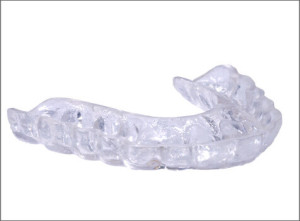 Soft internal surface rests comfortably against the teeth and gums while the hard occlusal surface provides durability and bonds with acrylic.
Soft internal surface rests comfortably against the teeth and gums while the hard occlusal surface provides durability and bonds with acrylic.
Custom Sports Mouthguards
Why Use a Custom Sports Mouthguards?
The purpose of the sports mouth guard is to act as a shock absorber in the mouth to protect the teeth from excessive forces. The mouth guard also protects your head and brain from concussion if the blow is onto the lower jaw. This is a significant reason in why boxers wear a mouth guard.
Need Mouthguards? Click
here to make an appointment
Custom Sports Mouthguards
- Mouthguards are a flexible appliance that is worn during athletic and recreational activities to prevent injuries to your mouth and face such as split lips, broken teeth and jaw fractures.
- Mouthguards should be worn when participating in activities such as basketball, football, soccer, wrestling, lacrosse rugby, hockey, martial arts, skateboarding.
- Custom made mouthguards provide superior fit and retention compared to boil and bite mouthguards. Custom made mouthguards offer 6 levels of protection from
Junior, Light, Light pro, Medium, Heavy, Heavy pro ---> With 3-5 mm of thickness - Not all guards are created equal :Comparing dentist-fabricated, custommade sports mouthguards, with stock or boil and bite guards reveals significant differences , boil and bite mouthguards do not fit accurately as custom made types
- Uncomfortable
- Interfere athletes ability to breath and speak.
- Boil and bite mouthguards are not as thick and provide false sense of protection
- According to national youth sports foundation more than 5 million teeth will be knocked out in sporting activities this year. These traumas will happen to children, high school and collegiate athletes, which can be easily avoided by using custom sports mouthguards.
Snoring & Sleep Apnea
Need Snoring & Sleep Apnea? Click
here to make an appointment
- Snoring can be a real problem not only for the person who snores but for the partner and other family members who live with snorer.
- Dentist can help providing the solution for the more restful night’s sleep.
- Silent nite is a custom fabricated dental appliance which helps to move the lower jaw in a slightly forward position opens up space in the airway tube and makes special side links connectors are attached to transparent breathing flexible upper and lower splints; it is comfortable, easier. Fits very good and allows uninhibited oral breathing.
- What is Sleep Apnea?
Sleep Apnea is a serious potentially life threatening sleep disorders that affects approximately 18 million Americans. It refers to episodes in which a person stops breathing for 10 secs or more during sleep. With each episode a person’s brain briefly wakes up in order to resume breathing resulting in poor quality of sleep. - Symptoms of Sleep Apnea:-
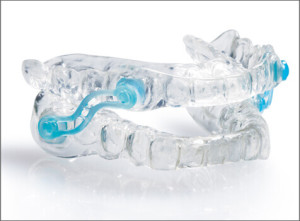
- Morning headaches
- Excessive daytime sleepiness.
- Irritability and impaired mental or emotional functions.
- Excessive snoring, gasping during sleep.
- Insomnia
- Awakening with a dry mouth/soar throat
- If left untreated Sleep Apnea can lead to high blood pressure, heart attack, even stroke.
- Dentist need to work closely with your physician to implement prescribed therapy, overnight sleep study which measures the heart rate and how many times breathing is interrupted during sleep.
The EMA (Elastic Mandibular Advancement) is a custom made removable appliance for treatment of obstructive sleep Apnea. It is designed to both advance the lower jaw and open the bite to enable less restricted airflow during sleep.
EMA appliance help to promote a deeper more restful sleep.
TAP(Thornton Adjustable Positioner) is appliance which opens up the airway, it hold the lower jaw in a forward position, maintaining clear airway to reduce snoring and improve breathing.


